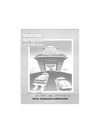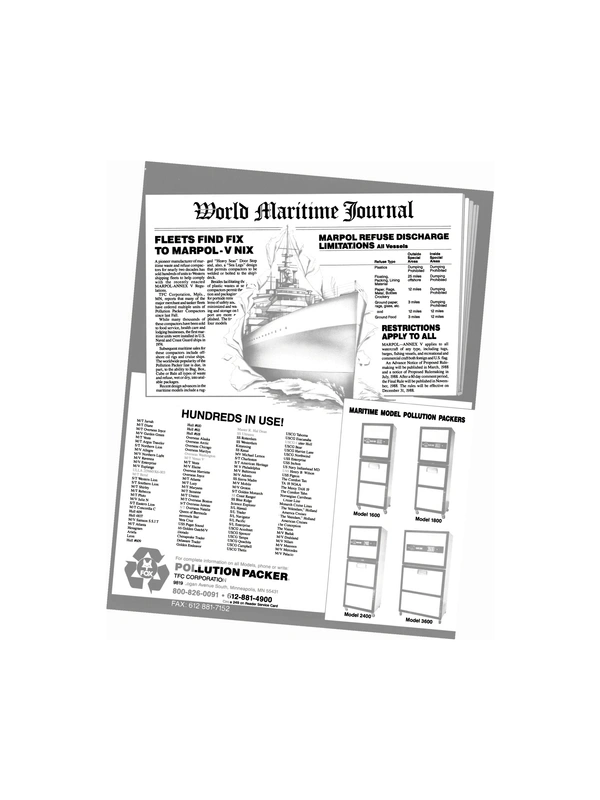
Selecting Machinery For High-Powered Cruise Ships
—Literature Available— Machinery selection for a cruise ship is a demanding task. Compared with other ship types, there are many unique requirements for cruise ship machineries. Passenger demand must be given the highest priority when selecting machinery concepts.
The machinery should not be obvious from the passengers' point of view. Three of the most important passenger requirements are: no vibration, no noise and no smoke.
From the interior designer's point of view the machinery should be small and compact. The shipowner is responsible for the rest: to ensure that the ship keeps the itinerary economically and safely. He not only has to comply with the wishes of his customers, but also must make sure that the machinery provides highest reliability, high flexibility, low operating costs and low investment costs.
At first glance all these requirements might seem difficult to comply with. Fortunately, experience has shown that all of them can be met. The latest trends in cruise shipping clearly indicate that one of the most rational alternatives in a cruise liner is a medium-speed pow- er plant. But what are the most efficient and most flexible solutions available?
There are two general trends in machinery concepts. Both point in the same direction but achieve their goals in slightly different ways: diesel mechanical machinery; and diesel electric machinery.
It is generally believed that diesel- electric propulsion is the only way to reduce vibration levels onboard a cruise ship. But the latest development in medium speed diesel engines have also made it possible to put very large main engines on resilient mountings, thereby meeting the strictest comfort requirements.
Wartsila Diesel has developed this technology for its complete engine range, unit sizes from 700 to 19,500 bhp. It is possible for these to be directly mounted on the engine block without the need for a separate intermediate foundation.
This is possible because of the sturdy design of the engine block. This drastically reduces the required height in the engine room and the weight of the installation.
There are basically two different ways to install a main engine resiliency: under-critical mounting; and over-critical mounting.
The final selection depends mostly on the requirements. The best isolation of the main engines is achieved by the over-critical mounting, although this mounting is a little more complex to achieve.
However, many of the most recent Wartsila Diesel cruise ship references are based on over-critically mounted main engines. This is the case with the Future Seas being built by Atlantique and the latest newbuildings for Birka Cruises and Silja Line at Wartsila Marine Industries.
Since a cruise ship has an extremely wide speed range, there are huge demands on the flexibility of the machinery. A trial speed of 21 knots requires more than twice the output compared with a cruising speed of 16 knots. If the machinery is optimized for the trial speed condition, the machinery will be far from optimal at normal cruising speed, i.e., the speed where most of the fuel is burned. To solve such a dilemma, it is advantageous to have the machinery divided into at least four main engines. In this way there are a multitude of operating modes to choose from, depending on the cruising speed. It should be noted that contrary to the practice of may ship operators, there are operation modes where there is an advantage in having two engines in operation on one shaft and one engine on the other shaft. The energy loss coming from the counter rudder is only in the order of 2 to 3 percent, which can easily be won back with optimal engine loading.
In many types of ships there might be an advantage to produce all or part of the electricity onboard with shaft generators. Due to the huge electricity demand combined with a relatively low propulsion requirement on cruise ships it is usually advantageous to avoid shaft generators on cruise ships. The use of shaft generators on a cruise ship means that high propeller speed must be maintained at small propeller pitch when cruising. This seriously decreases propulsion efficiency and increases the level of propeller- induced vibration.
For cruise ships it is therefore important to sail according to a combinator curve. Tremendous savings in fuel consumption at partial speeds as well as a lower vibration level will be the results. On many of the most recent deliveries the electrical power is produced by auxiliary engines that burn heavy fuel oil.
Examples of such references are the Sovereign of the Seas, Birka Princess and Amorella.
Diesel electric machinery is a very elegant and sophisticated way to propel a ship. The main advantage is the flexibility achieved in this way. If the ship has machinery built according to the power house concept, there are several engines connected to a common electrical system from where both propulsion and auxiliary power are taken. By dividing the machinery into several units, it is relatively easy to program a load control system that will keep the engine loadings on optimal levels at all times. This is particularly successful if the machinery comprises engines of different unit sizes.
In this way harbor conditions will be covered by the smaller engines and cruising condition by the larger engines or by a combination of different sized engines.
Diesel electric machinery usually has higher initial costs, but on the other hand it offers possibilities for secondary savings. It is all too easy to disqualify the diesel electric machinery by looking at initial costs alone. However, these advantages may be difficult to estimate. There is more freedom to place the machinery in areas of the ship where a diesel mechanical machinery could not be placed. The machinery can be placed for optimal stability and space utilization. In this way the total cost of the ship can be reduced.
There are some recent Wartsila Diesel references with diesel electric propulsion: Wartsila Marine Industries' newbuildings for Carnival Cruise Line and the sail cruisers for Wind Star Cruises and SMT built by Ateliers et Chantiers du Havre in France.
In conclusion, even if selection of machinery for cruise ships has traditionally been difficult in the past, the latest developments in mediumspeed engine technology have made this job considerably easier. Wartsila has developed a complete range of medium-speed engines well suited to all sizes and types of cruise ships, and Wartsila Diesels have become one of the prime choices in highclass, high-powered cruise ships.
For free literature giving full information on Wartsila engines, Circle 62 on Reader Service Card
Read Selecting Machinery For High-Powered Cruise Ships in Pdf, Flash or Html5 edition of May 1989 Maritime Reporter
Other stories from May 1989 issue
Content
- NAPVO To Review Subchapter T Proposal page: 6
- Trinity Industries To Buy Bethlehem Steel's 74-Acre Beaumont, Texas, Facility page: 7
- Caterpillar Announces New Trademarks page: 7
- Comsat Maritime Services Publishes Cruise Ship SatCom Brochure page: 8
- CE&MCO Receives Order For Three Portainers From Maersk Container page: 8
- N.Y. Shipyard Drydocks 925-Passenger Cruise Ship page: 10
- MAN B&W Diesel To Takeover Sulzer's Diesel Activities page: 10
- BoatUFE Supplies Deck Caulking Compound For Cruise Ship Fantasy page: 11
- Port Canaveral Offers Homeport Development Package To 'Phoenix' Cruise Ship page: 11
- CRUISE + FERRY '89 page: 12
- THE EXPANDING CRUISE INDUSTRY—STILL MORE ROOM FOR GROWTH page: 14
- Construction Of First Of Two 70,000-GRT Cruise Ships Under Way At Fincantieri-Monfalcone Yard page: 17
- 70,000-GRT Superliner Takes Shape At Wartsila Marine's Turku Yard page: 18
- Nichols Bros/ Deutz MWM-Powered Ocean Catamaran Goes Into Service Between Nantucket And Boston page: 20
- Gladding-Hearn Building Another High-Speed INCAT Ferry page: 20
- Selecting Machinery For High-Powered Cruise Ships page: 21
- Fast SES Ferry Used In New Commuter Service Between L.I. And Manhattan page: 22
- Literature On Onboard Potable Water Disinfection Available From Everpure page: 22
- Service Marine Launches Modern 500-Passenger Dinner Boat For Cruise International page: 24
- Mackay, C.PIath Announce U.S. Sales, Service Pact page: 24
- Avondale Industries Wins Floating Prison Contract page: 25
- Seaco/Elliot Offers Improved Inflatable Rafts page: 25
- Liebherr Wins Large Gantry Crane Order From Japanese Shipbuilder page: 28
- LQMoffitt Merges With BFGoodrich page: 28
- ZF Of NA Introduces Extended Service Plan For Marine Transmissions page: 29
- Directions In Design Completes Interior Work On Two Sister Vessels page: 29
- New WD 234 Is Notable Addition To Line Of Deutz MWM High Performance Boat Propulsion Units page: 30
- COMSAT'S 'Cruise Calling' Makes Telephone Calls To And From Ship Easy, Clear, Direct And Private page: 30
- Alden's New Marine Fax Recorder Receives Weather Charts As Well As Navtex And Radioteleprinter Data page: 30
- AN UPDATE ON U.S. NAVY SHIP AND EQUIPMENT PROCUREMENT page: 33
- Avondale Awarded $319-Million Contract To Build Three Oilers page: 37
- Ingalls Shipbuilding Readies USS Wasp (LHD-1) For Delivery page: 38
- U.S. Navy Selects Bailey Network 90 System For New YTT Vessel page: 39
- Albert L. Bossier Jr. Named 1989 Nimitz Award Winner page: 40
- Sperry Marine, Philips To Cooperate On German ESM/ADF System page: 43
- Datrex Introduces Hydrostatic Release For Inflatable Life Rafts page: 43
- Poppe To Head Bailey Refrigeration's Miami Branch Operation page: 44
- SPD Awarded Contract To Supply Electric Plant Control Panel For Seawolf page: 44
- Robert A. Spoerl Named Chief Executive Officer At Coast Engineering page: 44
- Advanced Joiner Systems From Rockment Featured On New Cruise Vessels page: 45
- Mike Mitchell Appointed Raytheon Marine Company Marketing Manager page: 46
- New Free Brochure From Graboski Associates Details Graphics Work page: 46
- Coritz Appointed New VP And GM At IMO Pump Division page: 47
- J.M. Martinac To Build 2,560-Bhp Z-Drive Ship-Berthing Tug page: 47
- First Allison Gas Turbine Genset Shipped For DDG-51 Installation page: 48
- Universal Marine Medical Offers Reliable Source For Medical Supplies page: 49
- Mid-Coast Delivers Cummins-Powered Crabber-Tender page: 50
- Trinity Marine Group Delivers Two Crew Boats To Saudi Arabia page: 51
- Peters Named Managing Director, Raytheon Marine European Operations page: 52
- Jeffboat To Construct Three River-Tank Barges In $3-Million Contract page: 52
- Conrad Industries Delivers Second Set Of Twin Barges page: 53
- Unitor Group Reports 1988 Was Best Year Ever page: 53
- NOR-SHIPPING '89 Exhibition And Conference page: 54
- MWH Offers High-Quality, Inlet And Exhaust Valves For Marine Engine Applications page: 56
- Royal Schelde Launches Second Frigate In New Series page: 57
- Goldstar Precision Introduces New Generation Of Mono Radar page: 60
- Elomatic Group, Design Specialists, Offer Brochure On Engineering Services page: 60
- TFC Offers Major Price Reductions On New Line Of Waste Compactors page: 61
- Precision Control Offers Detailed Brochure On New Vacuum Flush Toilet page: 61
- Thomson-Gordon Appoints Hampton Sales Distributor page: 67
- MarineSafety Demonstrates Prince William Sound Simulation page: 68
- Furuno's New Improved Loran Provides Even Higher Position-Fixing Accuracies And Display Stability page: 68
- Viking's Commercial-Grade Six-Person Life Raft Exemplifies Modern Lifesaving Technology page: 71
- New Worldwide Distributor Network For EMD Power Products page: 72
- New SEA 156 VHF Marine Radio Keeps Complex Functions Simple page: 72


